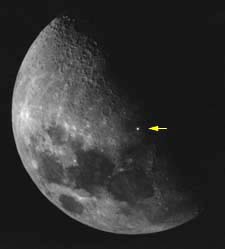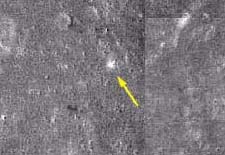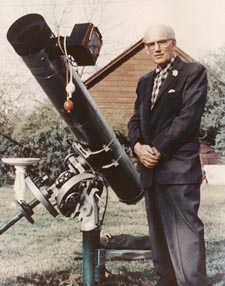
Leon H. Stuart's controversial photograph, taken at 2:00 Universal Time on November 15, 1953, records a bright flash seen against the lunar disk. With an estimated magnitude of –1, the flash persisted for at least 8 seconds.
Courtesy Jerry Stuart.
For the past few weeks, impact aficionados have been abuzz over the apparent confirmation that a house-size object struck the Moon on November 15, 1953. The bright flare captured that evening by Leon H. Stuart's backyard telescope matches the position of a small, fresh-looking crater recorded by a spacecraft four decades later. Bonnie J. Buratti (Jet Propulsion Laboratory) and Lane Johnson, a student at Pomona College, unearthed this 1½-kilometer-wide "smoking gun" in data from the Clementine orbiter, whose high-definition cameras mapped the entire Moon in 1994.
Although the annals of amateur astronomy chronicle hundreds of such transient lunar phenomena, almost all considered suspect by professionals, Stuart's event stands apart because it was both seen and photographed. That fact, together with the Clementine evidence, allowed Buratti and Johnson to make a convincing case in January's issue of the scientific journal Icarus. A press release even trumpeted "NASA Solves Half-Century Old Moon Mystery."

This fresh-looking lunar crater (arrowed) appears significantly brighter, and thus inherently bluer, in a mosaic of blue-light and near-infrared images from the Clementine spacecraft.
Courtesy Bonnie J. Buratti (Jet Propulsion Laboratory).
But a little more historical digging would have shown that there was no mystery to begin with. John E. Westfall (Association of Lunar and Planetary Observers) has discovered that the bright blip seen by Clementine also appears in a series of telescopic plates taken decades before Stuart snapped his controversial exposure. In particular, Westfall notes, the feature is "pretty obvious" in photographs made with Mount Wilson's 100-inch Hooker telescope in 1919. It also turned up on plates taken in 1937 with the 36-inch refractor at Lick Observatory and in others acquired with Catalina Observatory's 61-inch reflector in 1966.
"It's kind of disappointing," Buratti said when told of Westfall's revelation. "But it's more important to find that out." In researching their paper, she and Johnson had examined a few telescopic images for a small crater at the impact's presumed coordinates but found nothing. A search of Lunar Orbiter frames, taken during the 1960s, also turned up empty. They concluded that the candidate crater must be too small (roughly 0.8 arcsecond across) to be resolved by ground-based efforts.
Even before Westfall came forward, doubts had been growing about the Stuart-Clementine connection. For one thing, Stuart reported that the bright flare lasted at least 8 seconds, an implausibly long fireball for so small a crater. "We now know that an event of that scale should last no longer than a second, but [Stuart] didn't," comments impact specialist Alan W. Harris (Space Science Institute).

A respected radiologist in Tulsa, Oklahoma, Leon H. Stuart enjoyed observing with his home-built 8-inch f/8 Newtonian telescope. At its upper end is the plate camera used to record his controversial lunar flare on the evening of November 15, 1953.
Courtesy Jerry Stuart.
Other concerns were raised about the freshness of Buratti and Johnson's candidate crater. Solar-wind bombardment causes lunar material to darken and redden over time, but researchers believe such "space weathering" takes place slowly over millions of years. Thus, if 20-meter-wide objects slam into the Moon frequently (often enough to make Stuart's sighting statistically plausible), then the lunar landscape should be peppered with 100,000 bright, fresh-looking splashes — and it isn't. "You can't have it both ways," notes Harris.
Finally, the positional match wasn't as good as Buratti and Johnson first thought. Careful measurement of Stuart's image by Sky & Telescope editors Dennis di Cicco and Gary Seronik, as well as by Westfall, shows that the flare is centered a full 1°, or 30 km, from the Clementine candidate.
So, if it wasn't a flashy impact, what did Leon Stuart see and photograph a half century ago? Some have suggested that it was a "point meteor," headed directly at the camera, but that is ruled out by the flare's duration. Moreover, the spot on the photographic plate is perfectly round, arguing against a stray reflection or emulsion defect. In 1967 Stuart's original underwent a battery of tests at the University of Arizona's Lunar and Planetary Laboratory. But today the whereabouts of the original plate are unknown, and without it the true mystery of "Stuart's event" may never be solved.
 0
0
Comments
You must be logged in to post a comment.